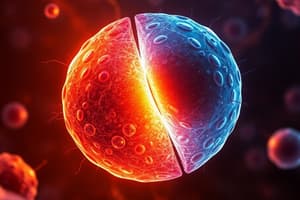Podcast
Questions and Answers
What is the primary function of the cell membrane?
What is the primary function of the cell membrane?
- To regulate what enters and leaves the cell (correct)
- To provide structural support to the cell
- To synthesize proteins
- To store genetic information
Which type of cell division results in four daughter cells with half the number of chromosomes as the parent cell?
Which type of cell division results in four daughter cells with half the number of chromosomes as the parent cell?
- Endosymbiosis
- Binary fission
- Mitosis
- Meiosis (correct)
What is the term for the movement of molecules through the cell membrane without the use of energy?
What is the term for the movement of molecules through the cell membrane without the use of energy?
- Passive transport (correct)
- Active transport
- Cell recognition
- Cell signaling
In which phase of mitosis do the chromosomes line up at the center of the cell?
In which phase of mitosis do the chromosomes line up at the center of the cell?
What is the role of cholesterol in the cell membrane?
What is the role of cholesterol in the cell membrane?
What is the term for the process by which a cell becomes specialized to perform a specific function?
What is the term for the process by which a cell becomes specialized to perform a specific function?
What is the primary difference between telophase I and telophase II in meiosis?
What is the primary difference between telophase I and telophase II in meiosis?
What is the primary function of the light-dependent reactions in photosynthesis?
What is the primary function of the light-dependent reactions in photosynthesis?
What is the primary purpose of the spindle fibers in mitosis?
What is the primary purpose of the spindle fibers in mitosis?
What is the primary function of lysosomes in animal cells?
What is the primary function of lysosomes in animal cells?
What is the primary difference between hormones and neurotransmitters?
What is the primary difference between hormones and neurotransmitters?
What is the primary function of the Golgi apparatus in animal cells?
What is the primary function of the Golgi apparatus in animal cells?
Flashcards are hidden until you start studying
Study Notes
Cell Membrane
- Also known as plasma membrane
- Thin, semi-permeable layer of lipid and protein molecules surrounding the cell
- Regulates what enters and leaves the cell through active and passive transport
- Composed of:
- Phospholipid bilayer (hydrophobic tails facing inward, hydrophilic heads facing outward)
- Embedded proteins (receptors, enzymes, transport proteins)
- Cholesterol (stabilizes membrane structure)
Mitosis
- Type of cell division that results in two daughter cells with same number of chromosomes as parent cell
- Occurs in somatic cells (non-reproductive cells)
- Phases:
- Interphase (cell grows, replicates DNA, and prepares for division)
- Prophase (chromatin condenses, nuclear envelope breaks down, and spindle fibers form)
- Metaphase (chromosomes line up at center of cell)
- Anaphase (sister chromatids separate and move to opposite poles)
- Telophase (chromosomes uncoil, nuclear envelope reforms)
- Cytokinesis (cytoplasm divides, and cell splits)
Meiosis
- Type of cell division that results in four daughter cells with half the number of chromosomes as parent cell
- Occurs in reproductive cells (gametes: sperm and egg cells)
- Phases:
- Interphase (cell grows, replicates DNA, and prepares for division)
- Prophase I (chromatin condenses, nuclear envelope breaks down, and spindle fibers form)
- Metaphase I (homologous pairs of chromosomes line up at center of cell)
- Anaphase I (homologous pairs separate and move to opposite poles)
- Telophase I (chromosomes uncoil, nuclear envelope reforms)
- Prophase II (chromosomes condense, nuclear envelope breaks down, and spindle fibers form)
- Metaphase II (chromosomes line up at center of cell)
- Anaphase II (sister chromatids separate and move to opposite poles)
- Telophase II (chromosomes uncoil, nuclear envelope reforms)
- Cytokinesis (cytoplasm divides, and cell splits)
Photosynthesis
- Process by which cells convert light energy into chemical energy
- Occurs in chloroplasts of plant cells and some algae
- Equation: 6 CO2 + 6 H2O + light energy → C6H12O6 (glucose) + 6 O2
- Steps:
- Light-dependent reactions (light energy excites electrons, which generate ATP and NADPH)
- Light-independent reactions (Calvin cycle: ATP and NADPH are used to convert CO2 into glucose)
Cell Signaling
- Process by which cells communicate with each other through signals
- Types of signals:
- Hormones (endocrine signals: released into bloodstream, affect distant cells)
- Neurotransmitters (released by neurons, affect nearby cells)
- Paracrine signals (released by nearby cells, affect adjacent cells)
- Autocrine signals (released by cells, affect same cell)
- Steps:
- Signal reception (signal binds to receptor on target cell)
- Signal transduction (signal is transmitted through cell, often involving second messengers)
- Response (target cell responds to signal, often involving changes in gene expression)
Animal Cells
- Characteristics:
- Lack cell wall
- Have true nucleus
- Have mitochondria
- Have centrioles (involved in formation of cilia, flagella, and spindle fibers)
- Have lysosomes (contain digestive enzymes)
- Have Golgi apparatus (involved in protein modification and transport)
- Can be totipotent (capable of giving rise to entire organism)
Studying That Suits You
Use AI to generate personalized quizzes and flashcards to suit your learning preferences.




